Most wild animals in the United States are reputable as aggressive and unapproachable. However, the country has a fair share of the most docile and timid animals. These animals hardly threaten humans, at least when in the tranquility of nature. You might be wary of getting close to these animals while in the zoo, animal parks, or simply hiking in the wild. It is natural to be uncertain whether they’ll intimidate you with their growls and frowns.
Determining whether a wild animal in the United States can be dangerous or harmless is often subjective. While some animals may remain peaceful unless provoked, others may exhibit defensive behaviors when they sense danger. Nevertheless, the animals featured in this article are considered entirely harmless. They typically opt for flight or display submissive behavior when approached by humans, showing a reluctance to engage in defensive attacks.

1. Opossums
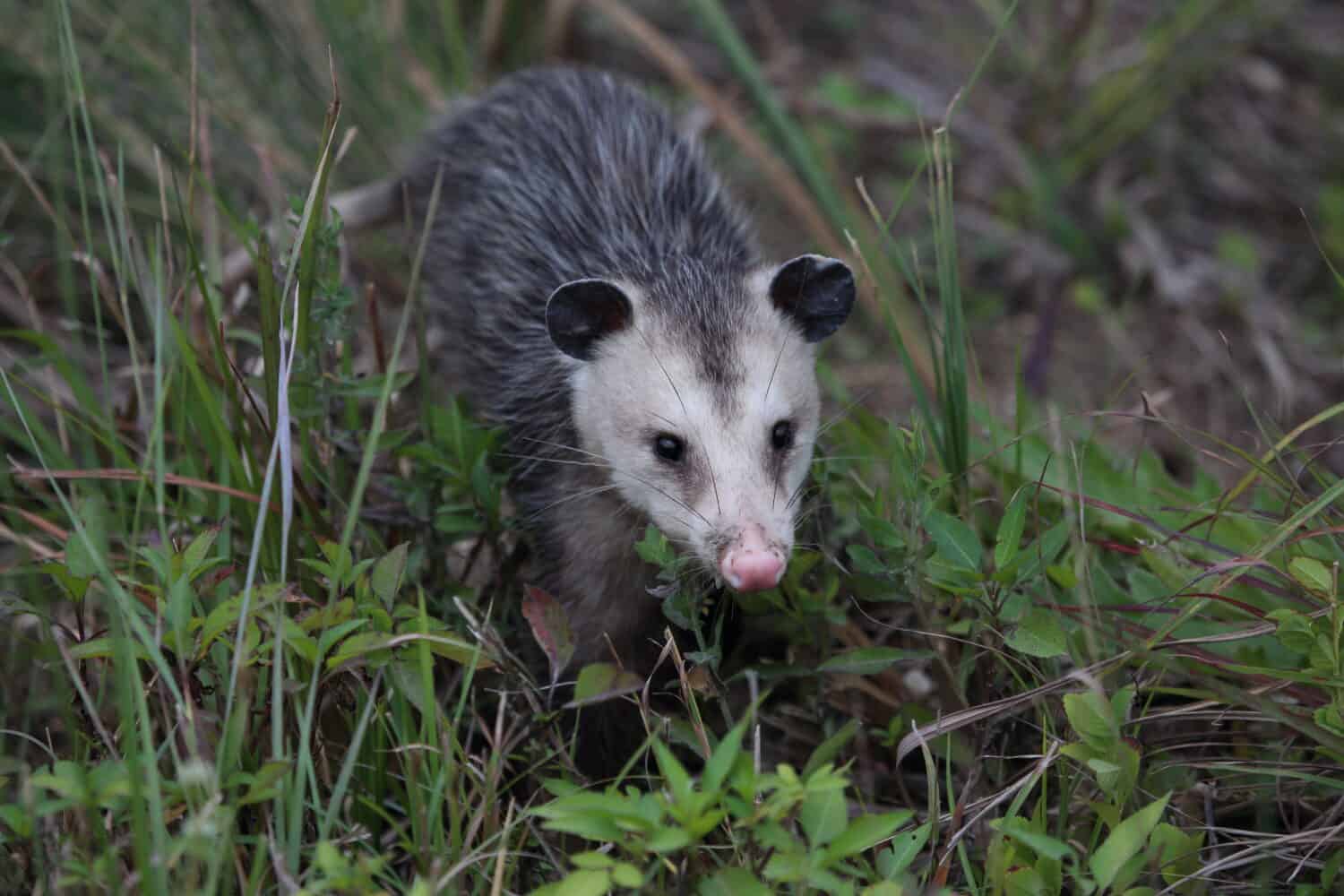
The opossum is a non-aggressive creature with a talent for playing dead.
©Arend Trent/Shutterstock.com
Opossums (Didephis virginiana) are almost found throughout the United States. They are generally non-aggressive but can display almost funny and quite mysterious mannerisms. They have a flair for theatrics and often play dead—or “play possum” in a pickle—when humans approach. These pose almost no threat to humans and are categorically harmless.
Opossums usually try to avoid human interactions and never venture into human settlements. They’re nocturnal, coming out to hunt at night when virtually no one is lurking around. Moreover, opossums also have an orthodox way of deterring the human approach. They typically hiss and growl to inform you that they don’t fancy your presence. Also noteworthy is that these animals can resist snake venom, making them the most daring in the wild.
2. American Toads
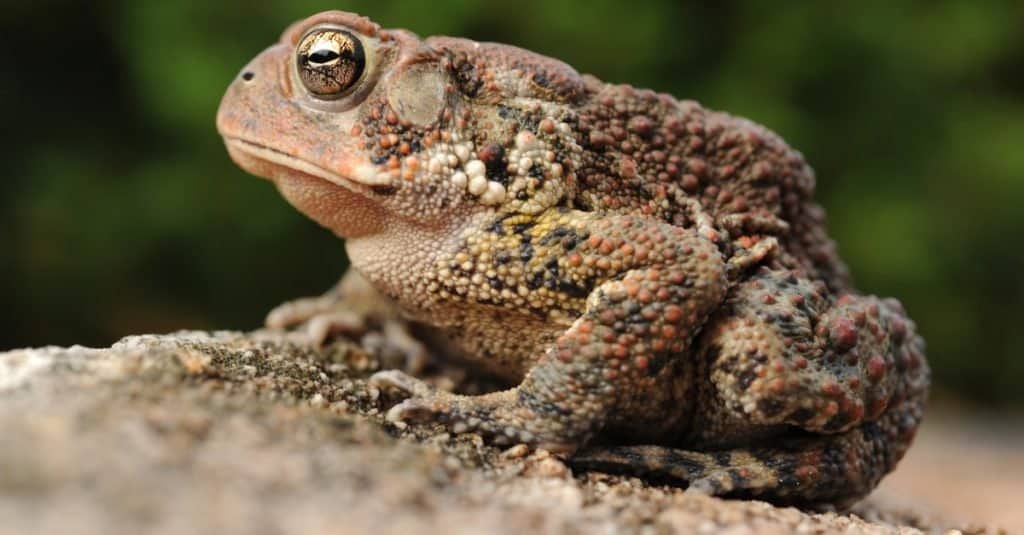
American toads produce a toxin called bufotoxin which is only harmful to other animals.
©Miles Boyer/Shutterstock.com
American toads (Anaxyrus americanus) are harmless and common in the United States. These amphibians typically exist in the Western and Central United States and some parts of the South. They’re only a threat to predators, and the toxin they produce, called bufotoxin, can only harm other animals. However, this excretion is non-toxic to humans. While these wild animals are not harmful to handle, washing your hands with soap and running water is advisable as a precautionary measure.
3. Garter Snakes
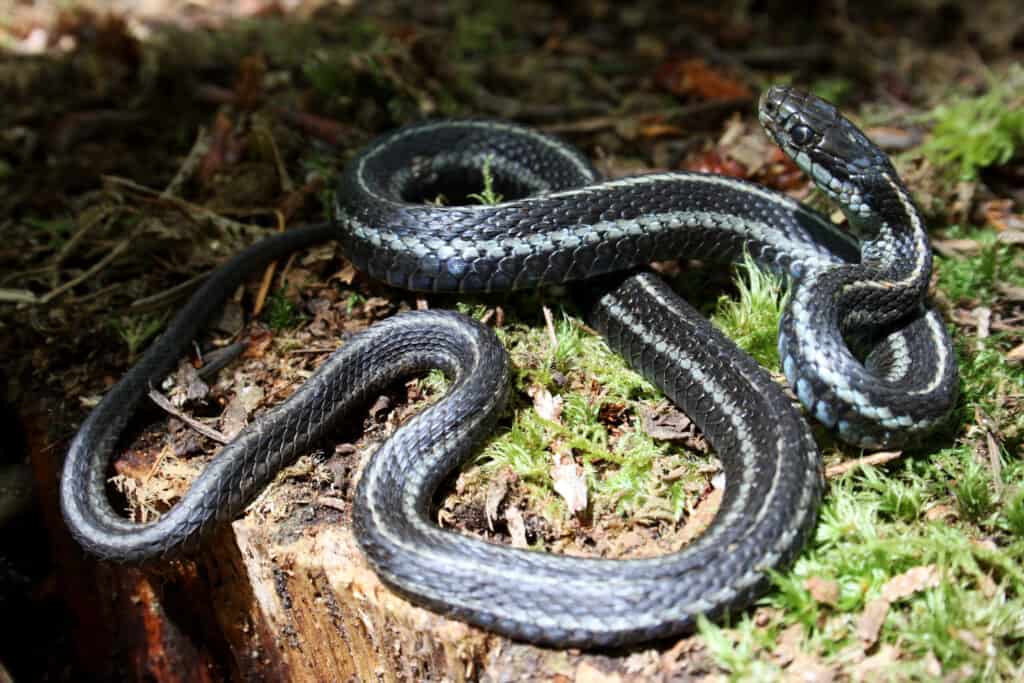
Garter snakes prefer staying away from humans and do not approach human dwellings.
©Colby Hess/Shutterstock.com
Snakes are a strict no to most humans. The vague thought at their very mention is their sharp fangs and intimidating hissing sounds. Nevertheless, the opposite is true for the garter snakes, as they’re typically harmless to humans. Garter snakes (Thamnophis sirtalis) are widespread from Alaska to Texas and Florida to Quebec and are non-venomous.
Despite their long sizes and body feints, these snakes ironically prefer to slither away when encountered by humans. They prefer staying away from humans and do not approach human dwellings. They’re also quite clever, mostly camouflaging and mimicking their surroundings to avoid predation. Moreover, they release a musky odor to keep humans away and can still administer non-venomous and harmless bites.
4. Manatees
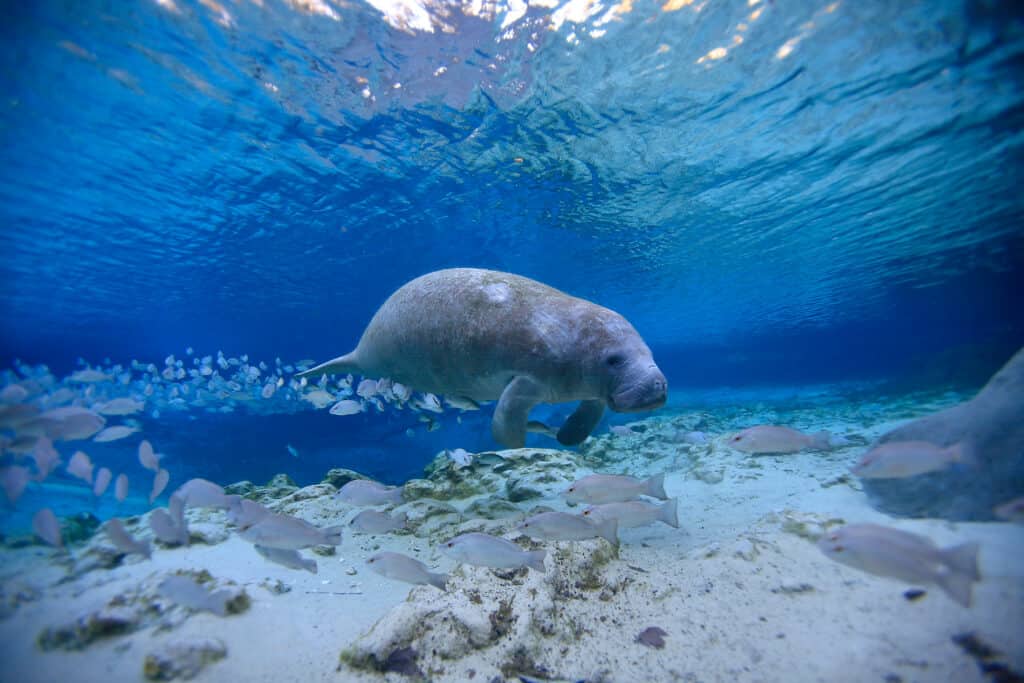
Despite their large size, manatees pose no threat to swimmers.
©Thierry Eidenweil/Shutterstock.com
Manatees (Trichechus manatus) typically grace shallow coastal waters, rivers, and estuaries with their colossal 10 – 12 feet size. Despite their large size, manatees pose no threat to swimmers. They are typically found along the coasts of Florida during winter. They migrate west to Texas, Georgia, and South Carolina during summer. They are generally solitary creatures. Occasionally they gather in small groups for companionship. Contrary to many other aquatic species, manatees breathe air. They possess a thick blubber for temperature regulation.
Manatees are slow-paced and non-aggressive. Therefore, consider yourself lucky if you’re a swimmer and they approach you in their habitats. These animals are almost stoic and seemingly never care about encroachers unless they feel threatened. They may only flee and find shelter from their predators, mainly bull sharks, alligators, and crocodiles.
5. White-Tailed Deer
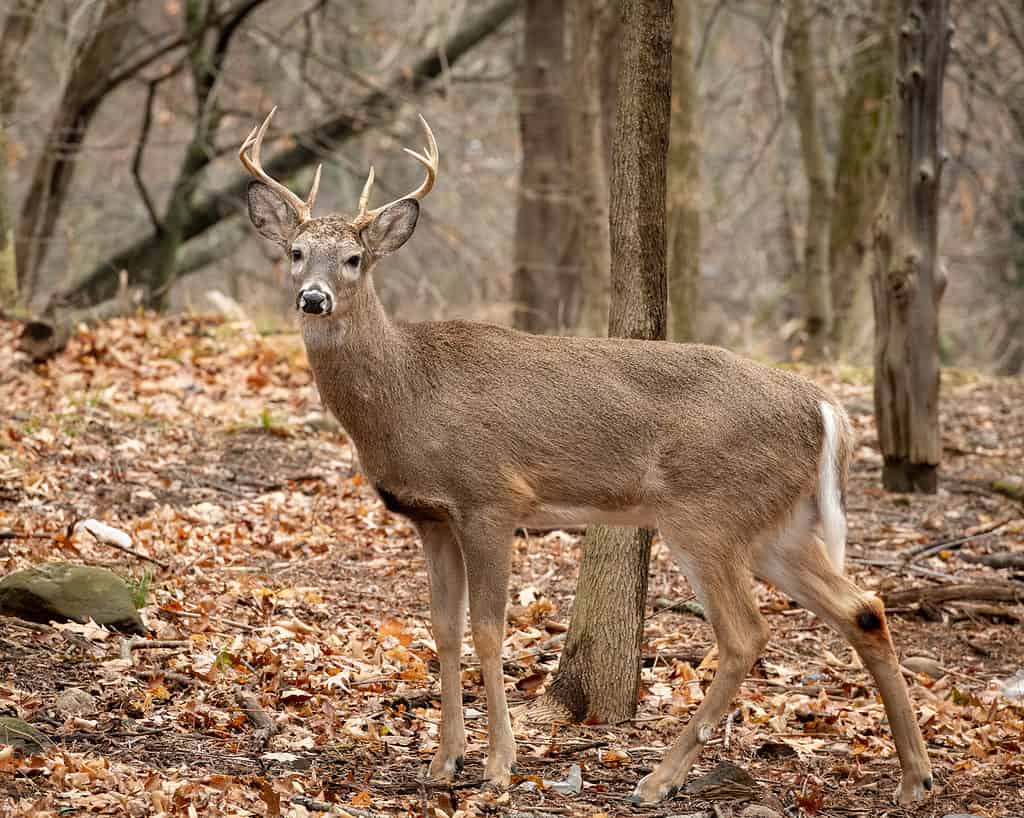
When approached, white-tailed deer intuitively flee.
©Herbie Pabst/Shutterstock.com
The white-tailed deer (Odocoileus virginianus) has huge antlers and a massive 31 – 40 inch body. However, they are docile and never fancy human presence. When approached, white-tailed deer intuitively flee. However, it’s usually best never to threaten their young since they can launch defensive attacks, as any other mother in the wild would. These pearls of the wild exist in the Eastern United States in states like Rhode Island and Hampshire. They’re also common in parts of the Midwest and Southern United States.
White-tailed deer depend on their speed for defense. They are always alert for possible danger from predators like tigers and panthers. Their unique keen sense of smell, sharp vision, and acute hearing make them almost unbeatable in the wild. They’re brilliant and always determine their course of action. They remain calm before responding to stimuli and can choose concealment instead of flight as a defense mechanism.
6. Eastern Chipmunk

These solitary yet friendly creatures swiftly escape from predators and hibernate during winter.
©iStock.com/rodmacpherson
Eastern chipmunks (Tamias striatus) are non-aggressive rodents harmless to humans. They’re typically lively during the day. You can often spot them in parks and fields foraging for food. Eastern chipmunks mainly exist in the Eastern United States in Virginia, North Carolina, and Vermont. They’re also popular in Florida and Georgia’s wild and parks. Their diet is simple: nuts and almonds, which they stash in their burrows during the summer. They, however, almost vanish during winter.
Eastern chipmunks are generally solitary, love exploring their surroundings unaccompanied, and flee when humans approach. These omnivores spend their days outside their burrows, sleep at night, and mostly hibernate during the winter when it’s frigid. They’re also agile and usually swiftly escape using their nimble limbs from predators, including birds of prey and snakes. These tree acrobats are proficient nut gatherers and can be friendly sometimes. They never turn a nut offer down if you don’t position yourself as a threat.
7. Gray Wolves

While timid by nature, these majestic creatures can be protective if provoked.
©Nagel Photography/Shutterstock.com
It might surprise you that wolves can be timid. Well, perhaps not generally. These beasts are conspecifics to steppe and Iberian wolves but are entirely harmless to humans. Contrary to popular belief, grey wolves (Canis lupus) mostly tend to avoid human contact. They dash away when humans approach and often keep to the woods and snowy mountains, which humans don’t easily access. They also move in packs, sometimes hunting together to increase their chances of cornering prey.
While they’re generally timid and don’t seek trouble, some gray wolves can aggressively attack when provoked. Mother gray wolves can be overly protective. When residing in an area with gray wolf packs, it’s best to understand the safety measures for peaceful coexistence. These beasts don’t intentionally harm humans; you can be safe around them if you move cautiously.
8. Eastern Cottontail Rabbit
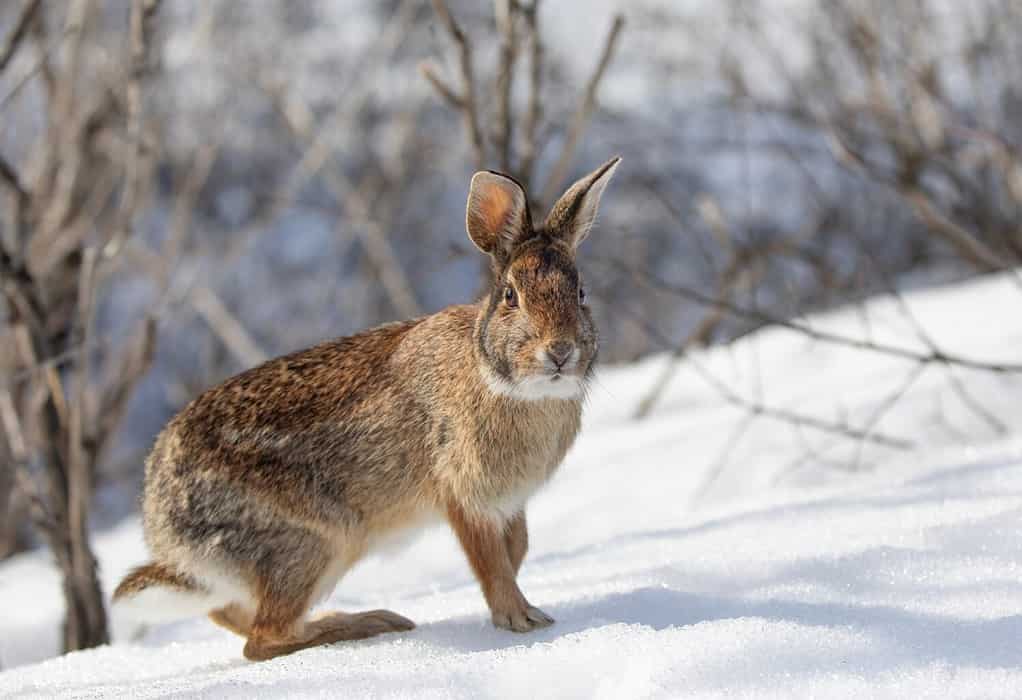
They are easily spooked and avoid human interaction as much as possible.
©Jim Cumming/Shutterstock.com
Eastern cottontail rabbits (Sylvilagus floridanus) are classified as species of “Least Concern,” according to the IUCN Red List categorization. They’re abundant throughout the eastern United States, mainly in Massachusetts, Rhode Island, and Connecticut. Moreover, areas of the central and southern United States boast huge numbers. Like most rabbit species, these big, fluffy wild animals are timid and harmless to humans. However, they can be a nuisance to farmers, destroying crops and obliterating ornamental landscaping.
Whether or not eastern cotton rabbits are harmless is subjective. You might never want these wild animals near your gardens if you’re a farmer or have a crop garden. However, you can rest assured knowing they’ll hardly encroach on your crops with high fences and ground reinforcements that prevent burrowing into your farm. These animals are easily spooked and avoid human presence as much as possible.
9. Eastern Box Turtle
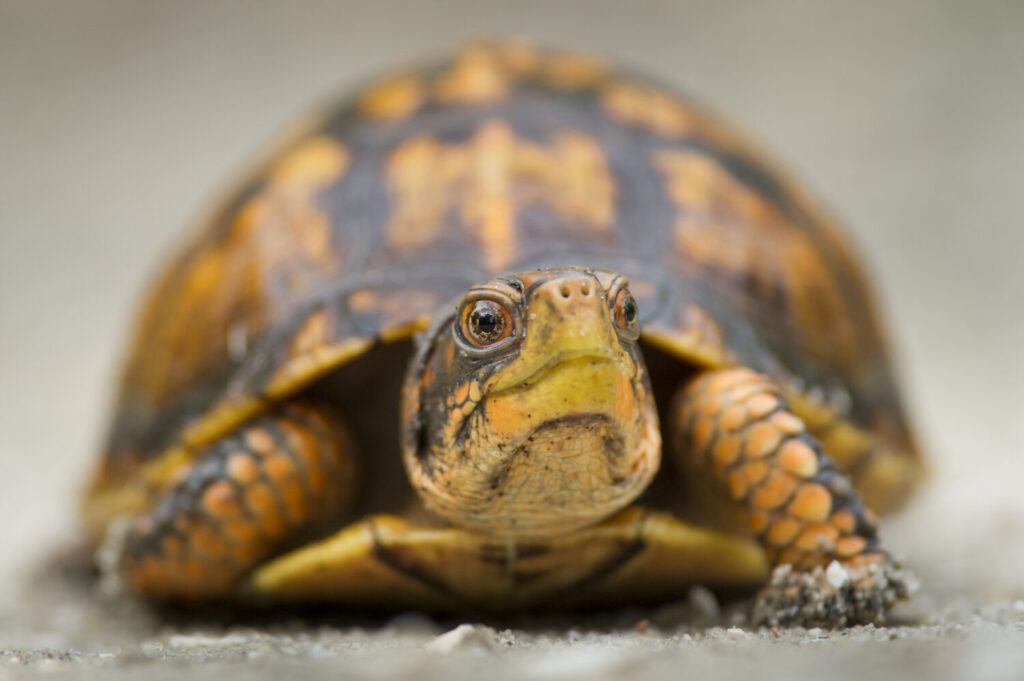
These animals usually hiss and bite as a last resort to defend themselves.
©Ray Hennessy/Shutterstock.com
The notion that brightly colored wild animals are often harmful doesn’t apply to the eastern box turtle (Terrapene carolina). This shell-dweller seems unbothered, usually retracting into its shell when danger knocks. It’s generally harmless, and despite these turtles having painted shells—often a warning for predators to keep off—it’s non-poisonous and approachable. The turtle isn’t aquatic but lives in the terrestrial areas of the Southeastern United States, in Georgia, Pennsylvania, New York, Alabama, and Maryland, among other states.
They do, however, make their feelings clear when threatened. They usually hiss and bite as a last resort to defend themselves. Moreover, they prefer camouflaging, staying calm until they feel less threatened. Unlike American toads, these reptiles don’t release toxic excretions but solely rely on their shells for protection from enemies. Eastern box turtles have incredibly long lifespans of about 50 years. Besides, they’re omnivorous and live solitary lives, far from human presence.
10. Basking Sharks

Despite their intimidating appearance, they are harmless and pose no threat to humans.
©Martin Prochazkacz/Shutterstock.com
Encountering sharks in the vast ocean can be unnerving, and most people prefer to keep their distance. However, if you encounter basking sharks (Coterhinus maximus), there’s no need to panic. These majestic creatures are harmless and pose no threat to humans, despite their intimidating appearance with wide-open mouths. Basking sharks are filter feeders, deliberately opening their mouths to gather zooplankton.
While these gentle giants pose no threat to humans, keeping a respectful distance and avoiding swimming too close to them is good. Please exercise caution and prevent any behaviors that could potentially provoke them. Their behavior, like that of any wild animal, can be unpredictable. Furthermore, reducing the risk of infrequent collisions may occur while these sharks swim nearby is prudent. These steps ensure a safer experience and avoid any potential discomfort or injuries.
11. Vultures
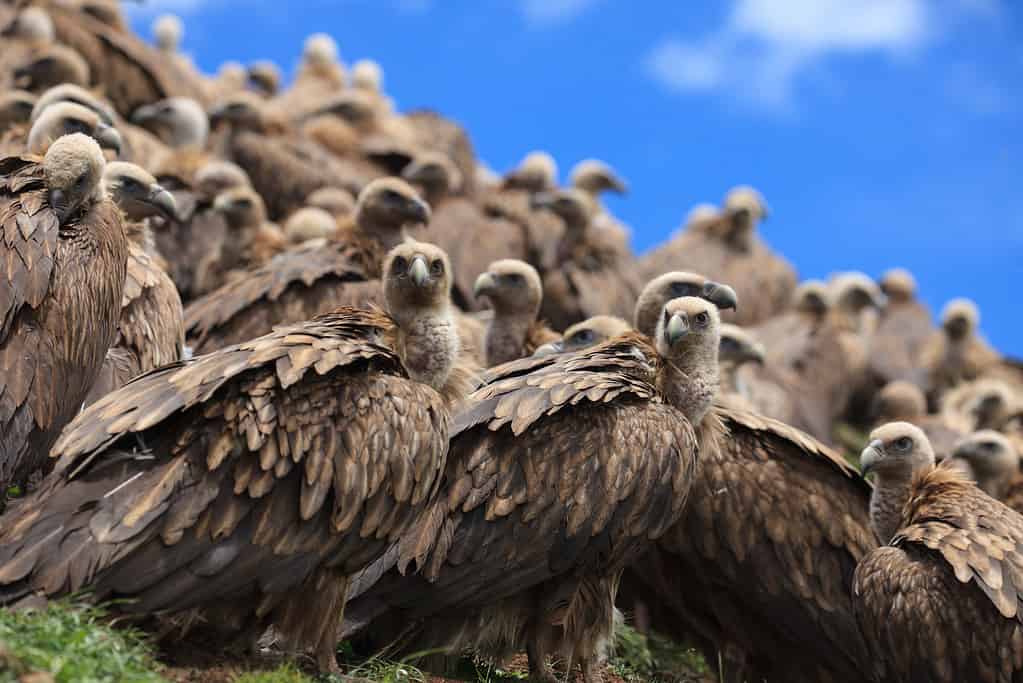
When faced with danger, they have a fascinating defense mechanism of regurgitating their food.
©JIEPENG XIE/Shutterstock.com
Vultures belonging to the Cathartes genus may appear intimidating with their imposing size and impressive wingspans ranging from 2.5 to 3.1 meters. However, these wild birds are actually timid and harmless. Despite their ability to hover overhead, they keep their distance from humans. Vultures are scavengers and feed on carcasses, showing no interest in attacking living humans or animals. Instead, they patiently await weaker or dying prey. So, while their presence may be imposing, vultures pose no direct threat to humans or healthy animals.
Vultures are widely distributed throughout the United States, making their presence known in the expansive skies, especially on clear days. An interesting defense mechanism they possess is the ability to regurgitate food when they feel threatened. Additionally, these birds gather in defensive groups, fending off potential attacks from other aerial predators. However, when humans approach, vultures typically take flight, perceiving our presence as a potential threat to their safety.
12. Monarch Butterfly
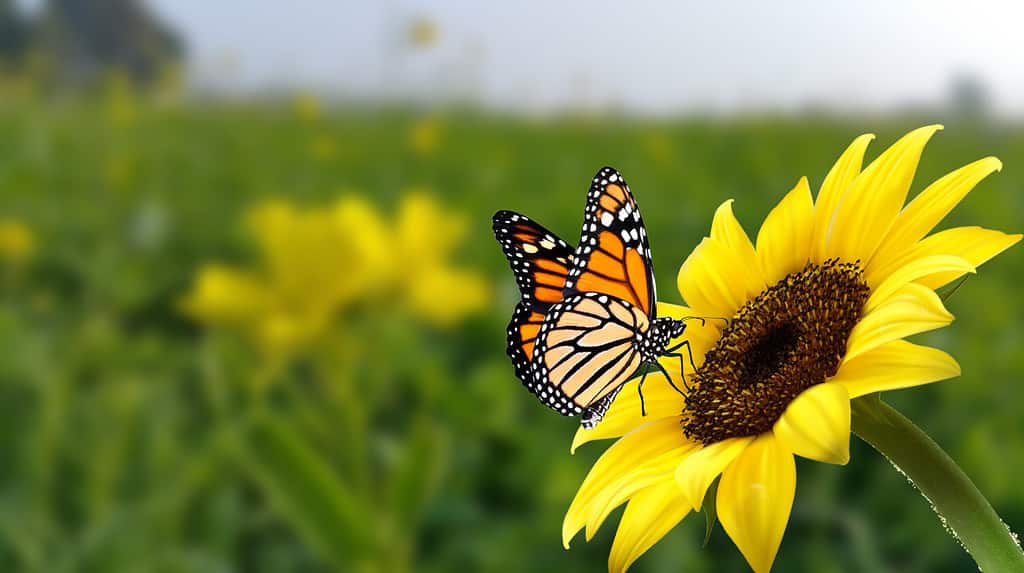
Harmless to humans, they flaunt their bright colors as a warning to predators, showcasing their fascinating defense mechanisms.
©Candy_Plus/Shutterstock.com
Butterflies are sought-after for their propensity to bring merry and grace to gardens. Butterflies play a crucial role in the ecosystem as pollinators and indicators of environmental health. They’re harmless, as is the monarch butterfly (Danaus plexippus). The Monarch exists in the eastern and central regions of the United States, including Kansas, Texas, Ohio, and Michigan, among other places. The butterfly can only grow about 4 inches; males are typically larger than females. These butterflies are harmless and, instead, more aesthetic and a welcome sight to the eye.
These insects neither bite nor produce toxins that irritate your skin or harm your health. However, they possess toxins called cardenolides, which only harm predators. They also have a bright coloration that serves as a warning to predators. You can freely interact with these insects in your gardens and the fields without worrying about harming you. However, it helps always to handle them carefully since they’re incredibly delicate.
13. Manta Rays
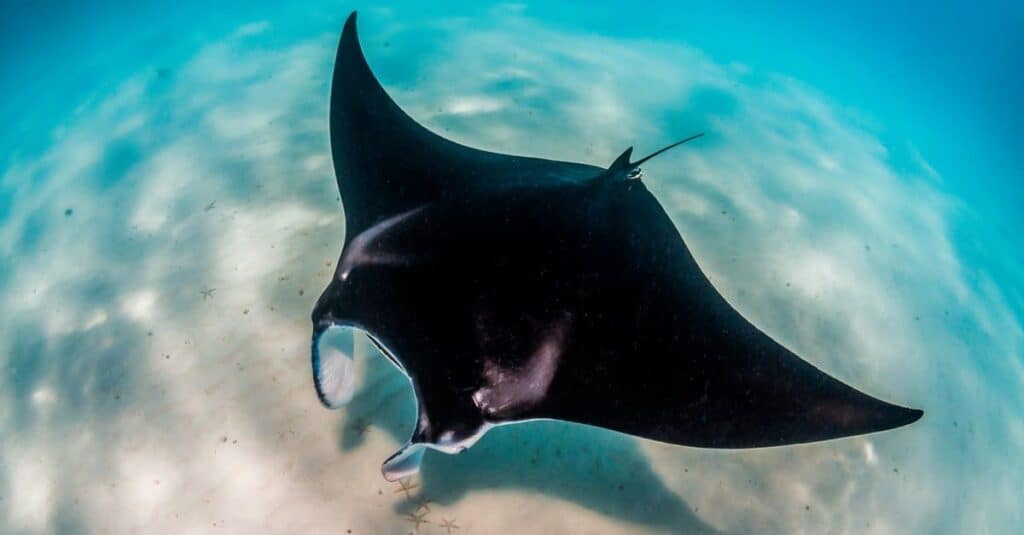
While they may retreat when approached, lucky encounters offer a rare opportunity to swim alongside these magnificent creatures.
©Aaronejbull87/Shutterstock.com
Floating in the shallow seas and gracing the waters are manta rays (Cephalospterus manta). These majestic aquatic creatures are colossal, measuring up to 9 meters. They’re harmless and peaceful and often glide in the waters freely amidst human presence. However, they usually flee when approached as they perceive humans as dangerous. On a good day, when lucky, you can enjoy these wild animals swimming alongside you.
Unlike stingrays, their cousins, manta rays don’t have stingers. You can find these aquatic creatures on the coasts of Southern Carolina, the Gulf of Mexico, Hawaii, and Florida. Possible close encounters include snorkeling or scuba diving, where they often seem to have no problems with human presence.
Always Keep Your Distance
Wild animals can be unpredictable and aggressive, even the most timid ones. While that’s their typical response to perceived threats, most docile animals avoid confrontations and take to their heels when they feel threatened. Most wild animals we’ve included in this article are approachable and often avoid humans as much as they can.
In conclusion, the United States is home to a variety of harmless wild animals, showcasing the beauty and diversity of its wildlife. These gentle creatures pose no threat to humans and often contribute positively to their ecosystems. We can foster a harmonious coexistence with nature by appreciating and protecting these harmless animals.
Summary of the 13 Most Harmless Wild Animals in the United States
| Number | Animal |
|---|---|
| 1 | Opossums |
| 2 | American Toads |
| 3 | Garter Snakes |
| 4 | Manatees |
| 5 | White-Tailed Deer |
| 6 | Eastern Chipmunk |
| 7 | Gray Wolves |
| 8 | Eastern Cottontail Rabbit |
| 9 | Eastern Box Turtle |
| 10 | Basking Sharks |
| 11 | Vultures |
| 12 | Monarch Butterfly |
| 13 | Manta Rays |
The photo featured at the top of this post is © Labrynthe/Shutterstock.com
Thank you for reading! Have some feedback for us? Contact the AZ Animals editorial team.






